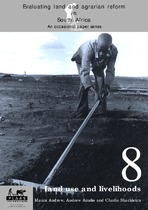| dc.contributor.author | Andrew, Maura | |
| dc.contributor.author | Ainslie, Andrew | |
| dc.contributor.author | Shackleton, Charlie | |
| dc.date.accessioned | 2019-03-07T11:59:35Z | |
| dc.date.available | 2019-03-07T11:59:35Z | |
| dc.date.issued | 2003 | |
| dc.identifier.citation | Andrew, M., Ainslie, A. & Shackleton, C., 2003. Land Use and Livelihoods. Cape Town: Institute for Poverty Land and Agrarian Studies (PLAAS). | en_US |
| dc.identifier.isbn | 1-86808-586-4 | |
| dc.identifier.uri | http://hdl.handle.net/10566/4416 | |
| dc.description.abstract | This paper addresses how land reform can contribute to enhancing land-based livelihoods.
South African agriculture is often characterised as being divided into two types: freehold
tenure/ commercial agriculture vs. communal tenure/ subsistence agriculture. Subsistence
uses of land are generally viewed as wasteful, destructive and economically unproductive in
comparison to commercial production systems. It is not surprising therefore that land
redistribution programmes which transfer land to subsistence producers are often viewed
with disdain. Such views inform recent land reform policy shifts aimed at enhancing ‘commercial’
agricultural production for the market rather than subsistence production. There is also an
emphasis on ‘full-time’ farming on larger portions of land to generate substantial agricultural
incomes.
These dualistic stereotypes are inappropriate and misleading. This dualism ignores the
many cases where small-scale producers in communal areas are currently involved in production
for the market (along with self-provisioning) as well as the more numerous historical examples
of such involvement. We also challenge the characterisation of subsistence land uses as
‘wasteful, destructive and economically unproductive’. There is considerable evidence that
land-based livelihoods have been significantly undervalued. This is not to say that there is no
room for improvement. Most poor rural households encounter considerable constraints to
production that limit their land-based livelihoods to a survivalist mode. The challenge for
South Africa’s land and agrarian reform programme is to alleviate the constraints to production
and, in so doing, to enhance land-based livelihoods amongst the poor majority beyond the
survivalist mode and to facilitate commercial production for the market amongst the elite.
This dualistic characterisation of South African agriculture should be replaced by a
‘continuum of farmers’ approach that recognises and supports a broad range of large and
small-scale, full-time and part-time, as well as commercial, peasant and subsistence farmers.
To justify the need for this ‘continuum of farmers’ approach, this paper highlights the wide
variety of productive uses of land and natural resources amongst residents of communal areas
and land reform beneficiaries, and the significant value of these uses. However, we also draw
attention to the constraints to land-based livelihoods in general and amongst land reform
beneficiaries in particular. The lack of land is one of these constraints but it is not the only
one. It is on this basis that we highlight the need for a broader agrarian reform programme
aimed at alleviating these constraints. | en_US |
| dc.language.iso | en | en_US |
| dc.publisher | Institute for Poverty Land and Agrarian Studies (PLAAS) | en_US |
| dc.relation.ispartofseries | Evaluating land and agrarian reform in South Africa;8 | |
| dc.subject | Land use | en_US |
| dc.subject | Livelihoods | en_US |
| dc.subject | Commercial agriculture | en_US |
| dc.subject | Subsistence agriculture | en_US |
| dc.title | Evaluating land and agrarian reform
in
South Africa : Land use and livelihoods | en_US |
| dc.type | Book | en_US |

